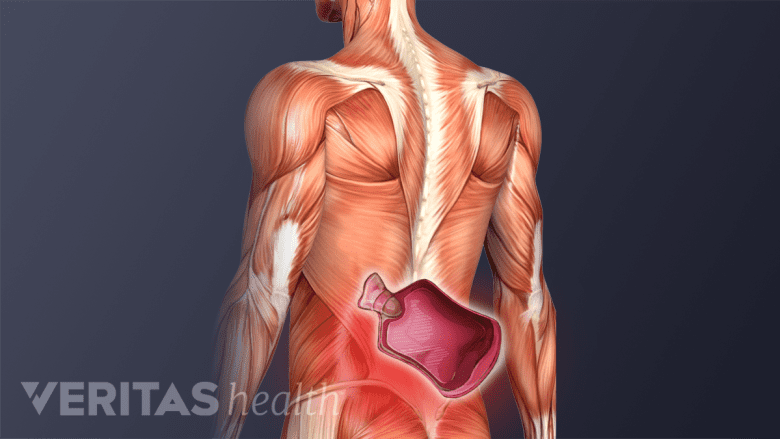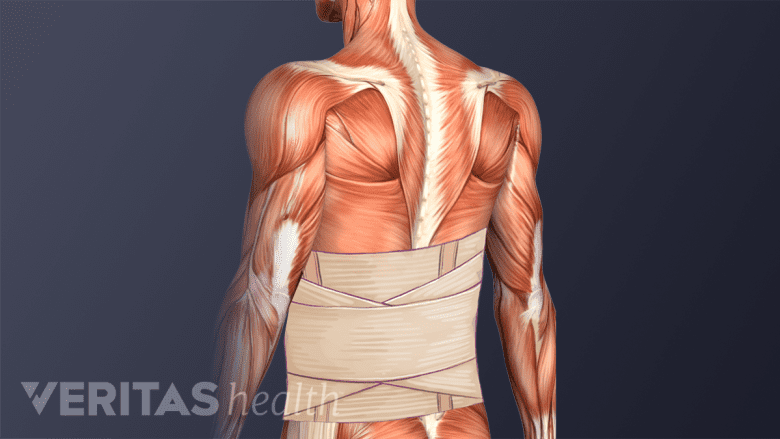Nonsurgical treatments are usually the first line of treatment and have a favorable success rate in terms of reducing pain that originates from a facet joint. A full range of treatments are available, and typically several are done at the same time.
For pain and dysfunction that does not respond to nonsurgical care, or for severe conditions, such as complex fractures, significant dislocations, or spinal cord involvement, surgical intervention may be recommended.
In This Article:
- Facet Joint Disorders and Back Pain
- Causes of Lumbar Facet Joint Disorders
- Symptoms and Diagnosis of Facet Joint Disorders
- Treatment Options for Facet Joint Disorders
- Surgery for Lumbar Facet Joint Disorders
Nonsurgical Treatments for Lumbar Facet Joint Pain
Several at-home and medical treatments are available to alleviate pain that originates in the lower back facet joints.
Self-care for lumbar facet joint pain
Treatments that may be performed at home to relieve lumbar facet pain include:
Applying heat therapy

Heat therapy boosts circulation, reduces spasms, and enhances spinal mobility
Heat therapy can help relax the muscles and open up blood vessels to allow blood flow and oxygen to reach the painful tissues, providing nourishment. Using a heat patch or hot water bag in the morning after waking may help ease the morning pain and stiffness. Heat therapy may also be used intermittently throughout the day to keep the tissues relaxed.
Using a cold pack

Cold packs reduce inflammation and numb the area.
Cold therapy may be used when the pain is acute or during a pain flare-up, such as after strenuous physical activity. A cold pack constricts the blood vessels, reducing blood flow to the region and numbing the pain.
See Ice Packs for Back Pain Relief
Supporting the lumbar curve
It is important to maintain the natural spinal alignment by using correct sitting, standing, and/or lying down posture. A good posture helps keep stresses off the facet joints and foster a better healing environment.
Avoiding activities that worsen the pain
In general, activities that include spinal twisting, repeated bending and extending, and sitting for long periods of time must be avoided. Bending the spine backward may cause more strain on the affected joint(s) and must be avoided to prevent further damage.
Staying active
While avoiding certain activities is recommended, it is also necessary to stay active in moderation and avoid complete bed rest, which may decondition the lumbar tissues and increase the pain.
Engaging in low-impact exercises
Following an exercise routine that involves simple, low-impact exercises, such as walking, may be beneficial when done within tolerable limits for short distances. Regular short walks can help avoid pain and stiffness from prolonged inactivity and also improve strength and flexibility in the lower back.
See Low-Impact Aerobic Exercise
Using a supportive brace

A lumbar brace helps stabilize the spine and relieve back pain.
While bracing is not common in treating benign facet pain, a brace may occasionally be used for non-threatening facet instability, such as a subluxation, to help limit spinal motion and promote healing.
See Using a Back Brace for Lower Back Pain Relief
It is advisable to discuss any activity modifications or self-care with a doctor to confirm that the facet disorder is not adversely affected.
Physical therapy
Hamstring stretches promote flexibility and reduce muscle tightness in the lower back.
Almost all treatment programs for facet joint disorders involve some type of structured physical therapy and exercise routine, which is formulated by a medical professional with training in musculoskeletal and spinal pain.
Physical therapy typically includes a combination of manual therapy, low impact aerobic exercise, strengthening, and stretching. Over time, this treatment is useful in improving and maintaining the stability of the lower back and fostering a healing environment for the tissues. When exercises are performed as directed, long-term pain relief may be experienced.
See Physical Therapy Benefits For Back Pain
Medication
NSAIDs reduce pain by calming inflammation in the nerves and soft tissues.
Both prescription and over-the-counter medications may be used for facet joint pain relief. Common oral medications include1Perolat R, Kastler A, Nicot B, et al. Facet joint syndrome: from diagnosis to interventional management. Insights Imaging. 2018;9(5):773–789. doi:10.1007/s13244-018-0638-x:
- Acetaminophen
- Nonsteroidal anti-inflammatory drugs (NSAIDs)
- Muscle relaxants
- Antidepressants
Topical pain-relieving medication may also be helpful to relieve local tenderness in the lower back and/or legs. Topical medications are available in the form of gels, creams, oils, and patches, and can be purchased over the counter.
See Medications for Back Pain and Neck Pain
TENS therapy
TENS therapy involves activating sensory nerve fibers through a tolerable frequency of electric current. The electric current is delivered through electrodes placed on the skin and attached to a TENS unit. TENS therapy may reduce facet joint pain by the production of endorphins—a hormone secreted by the body that reduces pain. This treatment is usually safe and can be done at home. However, there is limited scientific evidence supporting this treatment. A TENS unit can be purchased online or at a drug store.
See Transcutaneous Electrical Nerve Stimulators (TENS)
Injection therapy
Treatment injections contain numbing medications that work on the nerves around the facet joint, reducing their ability to carry pain signals to the brain. Injections also contain steroids, which decrease the inflammatory reactions in the facet joint, reducing the pain.
Common injection techniques that help target facet joint pain, include:
- Facet joint injections. These injections treat pain stemming from a specific facet joint. The injection is typically delivered into the capsule that surrounds the facet.
- Medial branch blocks. These nerve block injections deposit medication around the medial branches (pain transmitting branches) of spinal nerves.
- Radiofrequency Ablation (RFA). This injection treatment relieves pain by inducing a heat lesion on the pain-transmitting nerve near the facet. The lesion prevents the nerve from sending pain signals to the brain. An RFA is usually considered when an accurate diagnosis of facet joint pain is made through the diagnostic double block injection technique.
Spinal injections are almost always performed under the guidance of fluoroscopy (live x-ray) or ultrasound. A contrast dye is injected into the tissues to make sure the needle is accurately placed at the suspected site of pain. Medical imaging helps prevent injury and further complications that may be caused by injecting into adjacent structures, such as blood vessels.
Therapeutic injections using fluoroscopic guidance may not be given during pregnancy or when an infection or bleeding disorder is present. A small risk of bleeding, infection, allergic reaction, or permanent nerve or spinal cord damage.
A combination of one or more treatments is usually tried to control the symptoms of facet joint disorders. For the vast majority of patients, a combination of lifestyle changes, medication, physical therapy and exercise, and posture correction will help control the pain. If the pain and/or neurologic signs and symptoms, such as numbness or weakness, continue to progress, a surgical consultation may be recommended.
- 1 Perolat R, Kastler A, Nicot B, et al. Facet joint syndrome: from diagnosis to interventional management. Insights Imaging. 2018;9(5):773–789. doi:10.1007/s13244-018-0638-x

